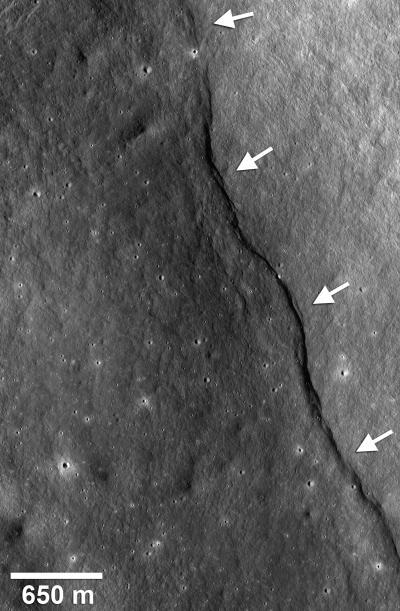The moon is about one-fourth the size of the Earth in diameter, it has shrunk about 200 meters (700 feet) in diameter over the 4.5 billion years of its existence, and it is generally considered devoid of geological activity. However, new research indicates that its core is still cooling, resulting in continued shrinkage of its diameter. The findings are reported in a paper co-authored by Smithsonian scientist Thomas Watters, “Evidence of Recent Thrust Faulting on the Moon Revealed by the Lunar Reconnaissance Orbiter Camera” published in the Aug. 20 issue of the journal Science.
The new research focuses on landforms called lobate scarps that appear as cracks or thrust faults over the moon’s crust. Lobate scarps were first identified in photos taken near the moon’s equator by the Apollo 15, 16, and 17 missions in the 1970’s; fourteen previously unknown lobate scarps scattered over other areas of the moon have now been revealed in very high resolution images taken by the Lunar Reconnaissance Orbiter Camera. The newly detected scarps indicate that the thrust faults are globally distributed, and the global distribution and the fact that they appear to be minimally weathered indicates that the geologic processes of cooling and shrinking that formed them are relatively recent.
“One of the remarkable aspects of the lunar scarps is their apparent young age,” said Watters of the Center for Earth and Planetary Studies at the National Air and Space Museum and lead author of the paper. “Relatively young, globally distributed thrust faults show recent contraction of the whole moon, likely due to cooling of the lunar interior. The amount of contraction is estimated to be about 100 meters in the recent past” (source). In an interview, Watters added: “These faults could be so young that they may be indicating very, very recent tectonic and, therefore, geologic activity on the moon. One of the general conceptions out there is that the moon is this geologically dead body, and that’s really not the case.” In astronomical and geological terms, “recent” means the past billion years or so, so don’t worry – the moon isn’t going to disappear any time soon.
Article by Bill Norrinton



